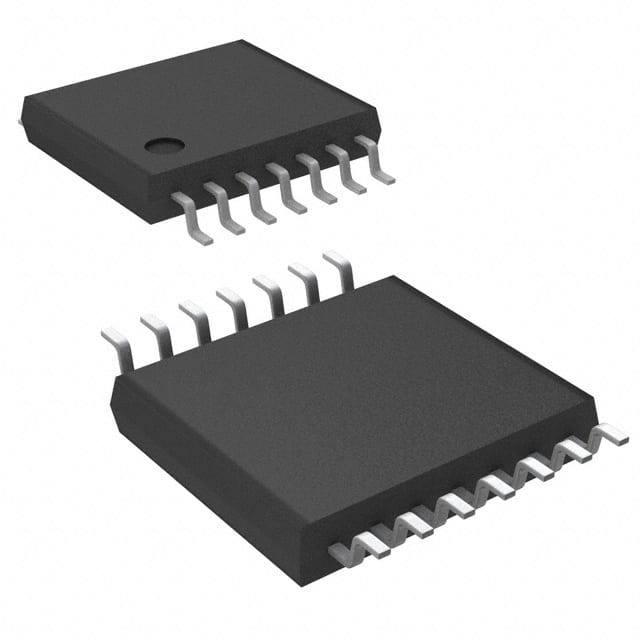Xem thông số kỹ thuật để biết chi tiết sản phẩm.

AD8402ARU100
Product Overview
Category
AD8402ARU100 belongs to the category of digital potentiometers.
Use
It is commonly used as a variable resistor in electronic circuits.
Characteristics
- Digital control interface
- Non-volatile memory for storing settings
- Low power consumption
- Wide operating voltage range
- High resolution and accuracy
Package
AD8402ARU100 comes in a small outline integrated circuit (SOIC) package.
Essence
The essence of AD8402ARU100 lies in its ability to provide a digitally controlled variable resistance, replacing traditional mechanical potentiometers.
Packaging/Quantity
AD8402ARU100 is typically sold in reels containing 250 units per reel.
Specifications
- Resolution: 8 bits
- Number of Channels: 2
- Operating Voltage Range: 2.7V to 5.5V
- Temperature Range: -40°C to +125°C
- Resistance Tolerance: ±20%
- End-to-End Resistance Range: 100Ω
Detailed Pin Configuration
AD8402ARU100 has a total of 16 pins, which are configured as follows:
- VDD: Power supply voltage
- GND: Ground reference
- SDA: Serial data input/output
- SCL: Serial clock input
- A0: Address bit 0
- A1: Address bit 1
- NC: No connection
- NC: No connection
- RDAC2: Terminal 2 of channel 2
- RDAC2: Terminal 1 of channel 2
- RDAC1: Terminal 2 of channel 1
- RDAC1: Terminal 1 of channel 1
- CS: Chip select input
- NC: No connection
- VLOGIC: Logic supply voltage
- NC: No connection
Functional Features
- Digital control interface allows for easy integration with microcontrollers and digital systems.
- Non-volatile memory ensures that the potentiometer settings are retained even when power is disconnected.
- Low power consumption makes it suitable for battery-powered applications.
- Wide operating voltage range enables compatibility with various power supply levels.
- High resolution and accuracy provide precise control over resistance values.
Advantages and Disadvantages
Advantages
- Easy integration with digital systems
- Retains settings without power
- Suitable for low-power applications
- Compatible with different power supply levels
- Provides high precision and accuracy
Disadvantages
- Limited resistance tolerance of ±20%
- Relatively small end-to-end resistance range of 100Ω
Working Principles
AD8402ARU100 utilizes a combination of digital control signals and internal circuitry to adjust the resistance between its terminals. The digital control interface allows users to set the desired resistance value, which is then stored in non-volatile memory. The potentiometer can be controlled using a microcontroller or other digital devices, providing a convenient and reliable method for adjusting resistance in electronic circuits.
Detailed Application Field Plans
AD8402ARU100 finds applications in various fields, including:
- Audio Equipment: Used for volume control and tone adjustment in amplifiers, mixers, and audio processors.
- Industrial Automation: Employed in control systems for precise resistance adjustments in industrial machinery.
- Test and Measurement Instruments: Integrated into equipment for calibration and signal conditioning purposes.
- Automotive Electronics: Utilized in automotive systems for sensor calibration and control circuitry.
Detailed and Complete Alternative Models
Some alternative models to AD8402ARU100 include:
- AD8400ARZ10: 10kΩ, 1-channel digital potentiometer
- AD8403ARZ50: 50kΩ, 4-channel digital potentiometer
- MCP4131-103E/P: 10kΩ, single-channel digital potentiometer
- MAX5486EUD+: 100kΩ, dual-channel digital potentiometer
These alternative models offer similar functionality and can be considered based on specific application requirements.
In conclusion, AD8402ARU100 is a digital potentiometer that provides precise resistance control in electronic circuits. Its digital control interface, non-volatile memory, and low power consumption make it suitable for various applications. While it has some limitations in terms of resistance tolerance and range, there are alternative models available to suit different needs.
Liệt kê 10 câu hỏi và câu trả lời thường gặp liên quan đến ứng dụng AD8402ARU100 trong giải pháp kỹ thuật
Sure! Here are 10 common questions and answers related to the application of AD8402ARU100 in technical solutions:
Q: What is AD8402ARU100? A: AD8402ARU100 is a dual-channel, digitally controlled potentiometer (DCP) that can be used in various technical applications.
Q: How does AD8402ARU100 work? A: AD8402ARU100 works by digitally controlling the resistance between its terminals using a serial interface.
Q: What is the voltage range of AD8402ARU100? A: The voltage range of AD8402ARU100 is typically from 0V to VCC, where VCC is the supply voltage.
Q: Can AD8402ARU100 be used as a variable resistor? A: Yes, AD8402ARU100 can be used as a variable resistor by adjusting its digital control inputs.
Q: What is the resolution of AD8402ARU100? A: The resolution of AD8402ARU100 is 256 steps, allowing for precise adjustment of resistance.
Q: Can AD8402ARU100 be used in audio applications? A: Yes, AD8402ARU100 can be used in audio applications for volume control or tone adjustment.
Q: Is AD8402ARU100 suitable for low-power applications? A: Yes, AD8402ARU100 has a low power consumption, making it suitable for low-power applications.
Q: Can AD8402ARU100 be used in industrial automation systems? A: Yes, AD8402ARU100 can be used in industrial automation systems for controlling various parameters.
Q: Does AD8402ARU100 have non-volatile memory? A: No, AD8402ARU100 does not have non-volatile memory. The resistance settings are lost when power is removed.
Q: What is the temperature range of AD8402ARU100? A: The temperature range of AD8402ARU100 is typically from -40°C to +85°C, allowing for operation in various environments.
Please note that these answers are general and may vary depending on specific application requirements and datasheet specifications.

